| Article ID | Journal | Published Year | Pages | File Type |
|---|---|---|---|---|
| 96279 | Forensic Science International | 2012 | 4 Pages |
This article describes the use of an anti-Stokes luminescent material (upconverter), yttrium vanadate doped with ytterbium and erbium (YVO4:Er,Yb), for the development of latent fingermarks on a range of non-porous surfaces. Anti-Stokes luminescent materials emit light at shorter wavelengths than the excitation wavelength. This property is unusual in both natural and artificial materials commonly found as exhibits in forensic science casework. As a result, fingermark detection techniques based on anti-Stokes luminescence are potentially extremely sensitive and selective.Latent fingermarks on non-luminescent and inherently luminescent substrates, including Australian polymer banknotes (a well-known ‘difficult’ surface), were developed with YVO4:Er,Yb by dry powder and wet powder techniques. The effectiveness of YVO4:Er,Yb for fingermark detection was compared with that of cyanoacrylate fuming and of sodium yttrium tetrafluoride doped with ytterbium and erbium (NaYF4:Er,Yb). The results illustrate some benefit of luminescent up-converting phosphors over traditional luminescence techniques for the detection of latent fingermarks.
